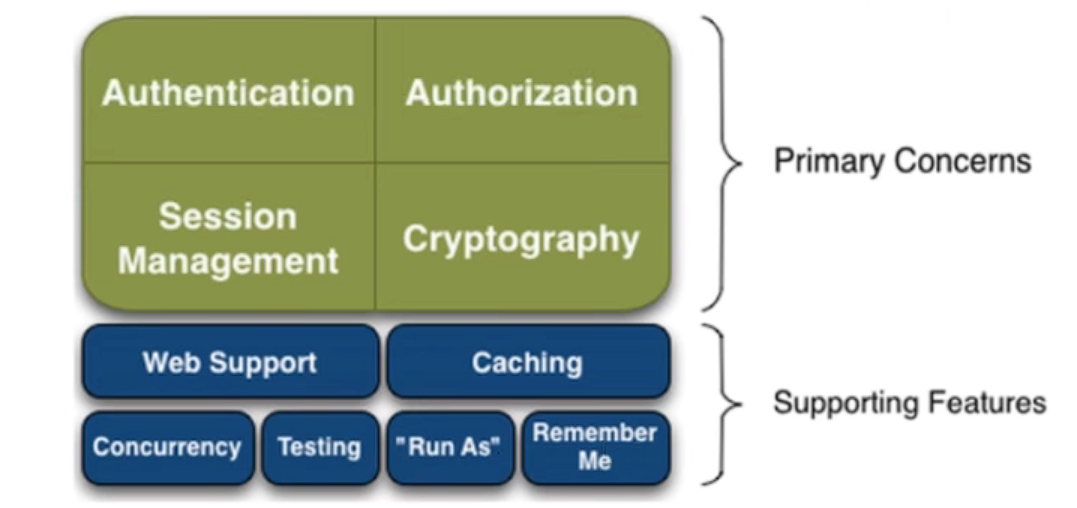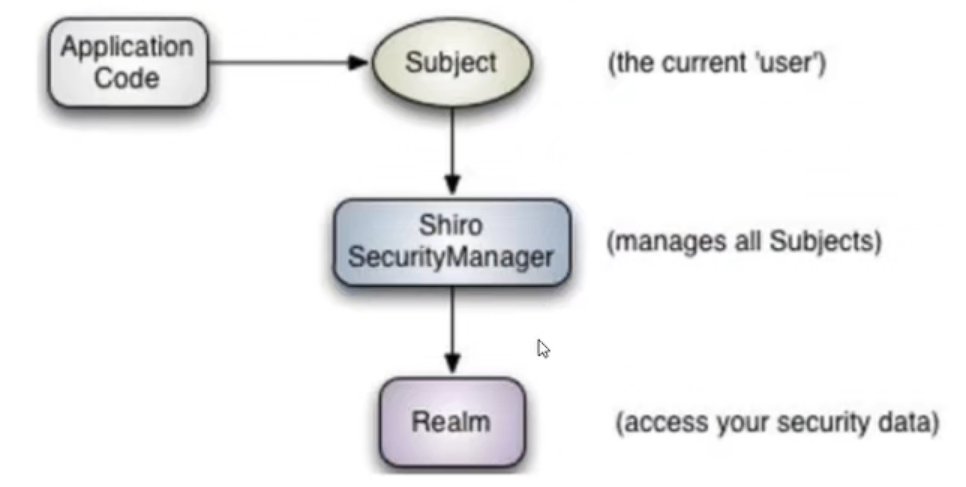" 常在河边走,哪能不湿鞋。" ——若发现文章内容有误,敬请指正,望不吝赐教,谢谢!
文章目录
参考资料
运行环境
- Windows10
- Maven 3.8.3
- IDEA 2021.1 专业版
- JDK 8
- SpringBoot 2.6
- Shrio 1.8
一、Shiro体系结构
Apache Shiro是一个强大且易用的Java安全框架,执行身份验证、授权、密码和会话管理。使用Shiro的易于理解的API,您可以快速、轻松地获得任何应用程序,从最小的移动应用程序到最大的网络和企业应用程序。

| 模块 | 描述 |
|---|---|
Authentication |
身份认证、登录,验证用户是不是拥有相应的身份 |
Authorization |
授权,即权限验证,验证某个已认证的用户是否拥有某个权限,即判断用户能否进行什么操作,如:验证某个用户已是否拥有某个角色,或者细粒度的验证某个用户对某个资源是否具有某个权限 |
Session Manager |
会话管理,即用户登陆后的第一次会话,没退出前,它的所有信息都在会话中,会话可以是普通的JavaSE环境,也可以是Web环境 |
Ctryptography |
加密,保护数据的安全性,如密码加密存储到数据库中,而不是明文存储 |
Web Support |
Web支持,可以非常容易的集成到Web环境 |
Caching |
缓存,比如用户登录后,其用户信息,拥有的角色、权限不必每次去查,这样可提高效率 |
Concurrency |
Shiro支持多线程应用的并发验证,即,如在一个线程中开启另一个线程,能把权限自动的传播过去 |
Testting |
提供测试支持 |
Run As |
允许一个用户假装为另一个用户(如果他们允许)的身份进行访问 |
Remember Me |
记住我,可在一定时间内记录保持登录的状态。 |
1.1 Shiro外部架构

Subject
Subject是应用代码直接交互的对象,也就是说Shiro的对外API核心就是Subject,Subject代表了当前的用户,这个用户不一定是具体的人,与当前应用交互的任何东西都是Subject,比如网络爬虫,、机器人等,与Subject的所有交互都会委托给SecurityManager;Subject其实是一个门面,SecurityManager才是实际的执行者。
SecurityManager
SecurityManager称为安全管理器,即所有与安全有关的操作都会与SecurityManager交互,并且它管理者所有的Subject,所以它称作为Shiro的核心,它负责与Shiro的其他组件进行交互,相当于SpringMVC框架的DispatcherServlet的角色
Realm
Shiro从Realm获取安全数据(如用户、角色、权限),就是说SecurityManager要验证用户身份,那么它需要从Realm获取相应的用户进行比较,来确定用户的身份是否合法,也需要从Realm得到用户相应的角色、权限,进行验证用户的操作是否能够进行,可以把Realm看成DataSource
1.2 Shiro内部架构

| 模块 | 描述 |
|---|---|
Subject |
任何可与应用交互的’用户‘ |
Security Manager |
相当于SpringMVC中的DispatcherServlet;是Shiro的心脏,所有具体的交互都通过SecurityManager进行控制,它管理所有的Subject,且负责进行认证,授权,会话以及缓存的管理。 |
Authenticator |
负责Subject认证,是一个扩展点,可以自定义实现,可以使用认证策略(Authentication Strategy),即什么情况下算用户认证通过了 |
Authorizer |
授权器, 即访问控制器,用来决定主体是否有权限进行相应的操作;即空值着用户能访问应用中的那些功能 |
Realm |
可以由一个或者多个的Realm,可以认为是安全实体数据源,即用于获取安全实体的,可以用JDBC实现,也可以是内存实现等等,由用户提供;所以一般在企业应用中都需要实现自己的realm |
SessionManager |
管理Session生命周期的组件,而Shiro并不仅仅可以用在Web环境,也可以用在普通的JavaSE环境中 |
CacheManager |
缓存控制器,来管理如用户,角色,权限等缓存的;因为这些数据基本上很少改变,放大缓存中后可以提高访问的性能 |
Cryptography |
密码模块,Shiro提供了常见的加密组件用于密码加密、解密等 |
二、Shiro 快速入门
Shiro 官方-快速入门地址:点击访问
Shiro 1.8 版本下载地址:点击访问

解压从官方下载的Shiro 1.8.0资源
访问解压后的目录D:\shiro1.8.0\shiro-root-1.8.0\samples\quickstart\src\main\resources
通过官方提供的快速入门Maven项目里的配置文件可以实现简单的应用
接下来的内容,部分是参考官方快速入门文档 ,大部分参考 视频资料
2.1 使用IDEA创建Maven项目,引入依赖
贴一个官方快速入门案例的依赖pom.xml,方便做参考
<?xml version="1.0" encoding="UTF-8"?>
<!--
~ Licensed to the Apache Software Foundation (ASF) under one
~ or more contributor license agreements. See the NOTICE file
~ distributed with this work for additional information
~ regarding copyright ownership. The ASF licenses this file
~ to you under the Apache License, Version 2.0 (the
~ "License"); you may not use this file except in compliance
~ with the License. You may obtain a copy of the License at
~
~ http://www.apache.org/licenses/LICENSE-2.0
~
~ Unless required by applicable law or agreed to in writing,
~ software distributed under the License is distributed on an
~ "AS IS" BASIS, WITHOUT WARRANTIES OR CONDITIONS OF ANY
~ KIND, either express or implied. See the License for the
~ specific language governing permissions and limitations
~ under the License.
-->
<!--suppress osmorcNonOsgiMavenDependency -->
<project xmlns="http://maven.apache.org/POM/4.0.0" xmlns:xsi="http://www.w3.org/2001/XMLSchema-instance" xsi:schemaLocation="http://maven.apache.org/POM/4.0.0 https://maven.apache.org/maven-v4_0_0.xsd">
<parent>
<groupId>org.apache.shiro.samples</groupId>
<artifactId>shiro-samples</artifactId>
<version>1.8.0</version>
<relativePath>../pom.xml</relativePath>
</parent>
<modelVersion>4.0.0</modelVersion>
<artifactId>samples-quickstart</artifactId>
<name>Apache Shiro :: Samples :: Quick Start</name>
<packaging>jar</packaging>
<build>
<plugins>
<plugin>
<groupId>org.codehaus.mojo</groupId>
<artifactId>exec-maven-plugin</artifactId>
<version>1.6.0</version>
<executions>
<execution>
<goals>
<goal>java</goal>
</goals>
</execution>
</executions>
<configuration>
<classpathScope>test</classpathScope>
<mainClass>Quickstart</mainClass>
</configuration>
</plugin>
</plugins>
</build>
<dependencies>
<dependency>
<groupId>org.apache.shiro</groupId>
<artifactId>shiro-core</artifactId>
</dependency>
<!-- configure logging -->
<dependency>
<groupId>org.slf4j</groupId>
<artifactId>jcl-over-slf4j</artifactId>
<scope>runtime</scope>
</dependency>
<dependency>
<groupId>org.slf4j</groupId>
<artifactId>slf4j-log4j12</artifactId>
<scope>runtime</scope>
</dependency>
<dependency>
<groupId>log4j</groupId>
<artifactId>log4j</artifactId>
<scope>runtime</scope>
</dependency>
</dependencies>
</project>
测试Demo的依赖 pom.xml
<?xml version="1.0" encoding="UTF-8"?>
<project xmlns="http://maven.apache.org/POM/4.0.0"
xmlns:xsi="http://www.w3.org/2001/XMLSchema-instance"
xsi:schemaLocation="http://maven.apache.org/POM/4.0.0 http://maven.apache.org/xsd/maven-4.0.0.xsd">
<modelVersion>4.0.0</modelVersion>
<groupId>com.uni</groupId>
<artifactId>shiro1</artifactId>
<version>1.0-SNAPSHOT</version>
<properties>
<maven.compiler.source>8</maven.compiler.source>
<maven.compiler.target>8</maven.compiler.target>
</properties>
<dependencies>
<dependency>
<groupId>org.apache.shiro</groupId>
<artifactId>shiro-core</artifactId>
<version>1.8.0</version>
</dependency>
<dependency>
<groupId>log4j</groupId>
<artifactId>log4j</artifactId>
<version>1.2.17</version>
</dependency>
<dependency>
<groupId>org.slf4j</groupId>
<artifactId>jcl-over-slf4j</artifactId>
<version>1.6.1</version>
</dependency>
<dependency>
<groupId>org.slf4j</groupId>
<artifactId>slf4j-log4j12</artifactId>
<version>1.6.1</version>
</dependency>
</dependencies>
</project>
2.2 配置Shiro
这里是参考官方案例里的配置
配置日志文件 log4j.properties
log4j.rootLogger=INFO, stdout
log4j.appender.stdout=org.apache.log4j.ConsoleAppender
log4j.appender.stdout.layout=org.apache.log4j.PatternLayout
log4j.appender.stdout.layout.ConversionPattern=%d %p [%c] - %m %n
# General Apache libraries
log4j.logger.org.apache=WARN
# Spring
log4j.logger.org.springframework=WARN
# Default Shiro logging
log4j.logger.org.apache.shiro=INFO
# Disable verbose logging
log4j.logger.org.apache.shiro.util.ThreadContext=WARN
log4j.logger.org.apache.shiro.cache.ehcache.EhCache=WARN
配置Shiro shiro.ini
[users]
# user 'root' with password 'secret' and the 'admin' role
root = secret, admin
# user 'guest' with the password 'guest' and the 'guest' role
guest = guest, guest
# user 'presidentskroob' with password '12345' ("That's the same combination on
# my luggage!!!" ;)), and role 'president'
presidentskroob = 12345, president
# user 'darkhelmet' with password 'ludicrousspeed' and roles 'darklord' and 'schwartz'
darkhelmet = ludicrousspeed, darklord, schwartz
# user 'lonestarr' with password 'vespa' and roles 'goodguy' and 'schwartz'
lonestarr = vespa, goodguy, schwartz
[roles]
# 'admin' role has all permissions, indicated by the wildcard '*'
admin = *
# The 'schwartz' role can do anything (*) with any lightsaber:
schwartz = lightsaber:*
# The 'goodguy' role is allowed to 'drive' (action) the winnebago (type) with
# license plate 'eagle5' (instance specific id)
goodguy = winnebago:drive:eagle5
2.3 测试运行官方的Quickstart实例
Quickstart.java
/*
* Licensed to the Apache Software Foundation (ASF) under one
* or more contributor license agreements. See the NOTICE file
* distributed with this work for additional information
* regarding copyright ownership. The ASF licenses this file
* to you under the Apache License, Version 2.0 (the
* "License"); you may not use this file except in compliance
* with the License. You may obtain a copy of the License at
*
* http://www.apache.org/licenses/LICENSE-2.0
*
* Unless required by applicable law or agreed to in writing,
* software distributed under the License is distributed on an
* "AS IS" BASIS, WITHOUT WARRANTIES OR CONDITIONS OF ANY
* KIND, either express or implied. See the License for the
* specific language governing permissions and limitations
* under the License.
*/
import org.apache.shiro.SecurityUtils;
import org.apache.shiro.authc.*;
import org.apache.shiro.config.IniSecurityManagerFactory;
import org.apache.shiro.mgt.SecurityManager;
import org.apache.shiro.session.Session;
import org.apache.shiro.subject.Subject;
import org.apache.shiro.util.Factory;
import org.slf4j.Logger;
import org.slf4j.LoggerFactory;
/**
* Simple Quickstart application showing how to use Shiro's API.
*
* @since 0.9 RC2
*/
public class Quickstart {
private static final transient Logger log = LoggerFactory.getLogger(Quickstart.class);
public static void main(String[] args) {
// The easiest way to create a Shiro SecurityManager with configured
// realms, users, roles and permissions is to use the simple INI config.
// We'll do that by using a factory that can ingest a .ini file and
// return a SecurityManager instance:
// Use the shiro.ini file at the root of the classpath
// (file: and url: prefixes load from files and urls respectively):
Factory<SecurityManager> factory = new IniSecurityManagerFactory("classpath:shiro.ini");
SecurityManager securityManager = factory.getInstance();
// for this simple example quickstart, make the SecurityManager
// accessible as a JVM singleton. Most applications wouldn't do this
// and instead rely on their container configuration or web.xml for
// webapps. That is outside the scope of this simple quickstart, so
// we'll just do the bare minimum so you can continue to get a feel
// for things.
SecurityUtils.setSecurityManager(securityManager);
// Now that a simple Shiro environment is set up, let's see what you can do:
// get the currently executing user:
Subject currentUser = SecurityUtils.getSubject();
// Do some stuff with a Session (no need for a web or EJB container!!!)
Session session = currentUser.getSession();
session.setAttribute("someKey", "aValue");
String value = (String) session.getAttribute("someKey"







 最低0.47元/天 解锁文章
最低0.47元/天 解锁文章















 591
591











 被折叠的 条评论
为什么被折叠?
被折叠的 条评论
为什么被折叠?








